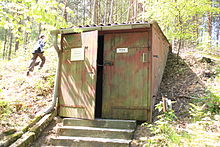Kossa-Söllichau bunker
The Kossa-Söllichau bunker was built as construction project no. 16/13/302 in the period from 1976 to 1979 based on projects from the Special Construction Administration by engineering groups of the NVA and special companies of the GDR . The facility is located north-east of Leipzig in the Dübener Heide between the communities of Kossa and Söllichau .
Structure of the plant
The facility consisted of an arrangement of six prefabricated bunkers of the type FB-75 with protection class "E", which would have withstood a nuclear weapon detonation of 1 kp / cm² with an overpressure in the pressure wave front. The facility included several small FB-3 bunkers for the protected accommodation of the security and maintenance personnel, as well as numerous splinter protection covers for the covered parking of vehicles. There was no underground connection between the individual precast bunkers.
Function and intended purpose
In the event of war , Military District III (Leipzig) would have been dissolved. Associations, troops, units and facilities would have been merged into a military association, the 3rd Army of the NVA. Other institutions and forces formed the Territorial Military District III. Both structures represented institutions that acted independently. The 3rd Army was incorporated into the combat order of a joint front made up of the GSSD and NVA. The area of their operational purpose was deep in the south of the GDR. The bunkered command post Mosel near Zwickau was prepared for the initial situation .
Kossa / Söllichau, as the command post of the Territorial Military District, had to fulfill purely national tasks. An army was not led here, nor was it a "secret treasure" of the Warsaw Pact. Their main task was to prepare and organize the formation of replacement and training brigades (EABr.) And their leadership. Like all prepared leadership positions, a small maintenance unit kept it in constant readiness for occupancy.
Sub-segments of the bunker system
The individual bunkers of the command post differ in terms of their purpose. While the work rooms of the staff departments as well as the situation and information center dominated the command bunker, the message center was installed in another bunker. At the same time, this offered the possibility of storing the mobile communications equipment carried when it was occupied, in particular radio and directional radio equipment. The supply technology was again housed in another bunker.
Message center
The message center was installed in one of the prefabricated bunkers, which was flanked by six vehicle halls. Up to four mobile communication vehicles could be safely parked in each of the halls. In peacetime these news vehicles did not exist in Kossa-Söllichau. They were only added when the system was occupied. Their task was to ensure radio and microwave links, duplicating the existing wired connections.
Without occupying the system, the message center had a stationary transmission point (channel-forming device) with the necessary connection, measuring and adjustment devices as well as a telephone exchange . A handling facility was available to ensure the exchange of information.
The news center was integrated into the country's command system, which had been prepared for the event of war. It was assigned the designation auxiliary message center 63 (HNZ 63). In the primary group network of the NVA, there were only prepared news channels to the auxiliary news center 4 (HNZ 4) in Hennickendorf (management level Ministry for National Defense ).
There were no direct communication links from the command post / HNZ 63:
- to the main news center of the Ministry of National Defense,
- to the main command post of the NVA in the Harnekop bunker ,
- to the General Staff of the Soviet Armed Forces in Moscow ,
- to the High Command of the United Armed Forces of the Warsaw Pact in Moscow,
- to the staff of the United Armed Forces in the west direction Legnica / VR Poland .
From the command post / HNZ 63 it was not possible:
- To send messages (information of any kind) by means of a tropospheric radio station through mushroom clouds,
- To transmit battle plans to the war front with a "sophisticated video system" ,
- to realize a “mechanical-automatic troop command” (whatever the authors of such terms mean - the NVA's military strategy does not know this).
The existing video system could only be used to transfer images between the work rooms.
Post-turn use
After German reunification , the facility was no longer needed. The Bundeswehr made the entire area available for private use in 1993. Interested parties secured the remains, received them and were able to receive the status of cultural monument in 2002 . At the same time, the facility was opened as a museum. Their function and intended purpose are overrated in public media and on guided tours. From the beginning to the end, it remained a command post for the NVA to set up replacement and training brigades in the southern districts of the GDR. For the northern districts of the GDR there was a command post with the same function and purpose. Several thousand visitors come to the Düben Heath every year.
See also
literature
- Joachim Kampe: Wostok - the news center in the center of the military power of the GDR , ISBN 3-932566-60-2
- Hans-Werner Deim, Hans-Georg Kampe, Joachim Kampe, Wolfgang Schubert: The military security of the GDR in the Cold War , ISBN 978-3-932566-80-6
- Joachim Kampe: The tropospheric message system "BARS" and the bunker facility Wollenberg , ISBN 978-3-932566-90-5
Web links
- Official website of the Military Museum Bunker Kossa
- Bunker Wollenberg / tropospheric radio station
- Spiegel contribution - "Brain in the heath"
- "Kossa" the other bunker
- Bunker Kossa-Secret ... Critical to a TV documentary of the MDR
Coordinates: 51 ° 38 ′ 31 " N , 12 ° 42 ′ 47" E




